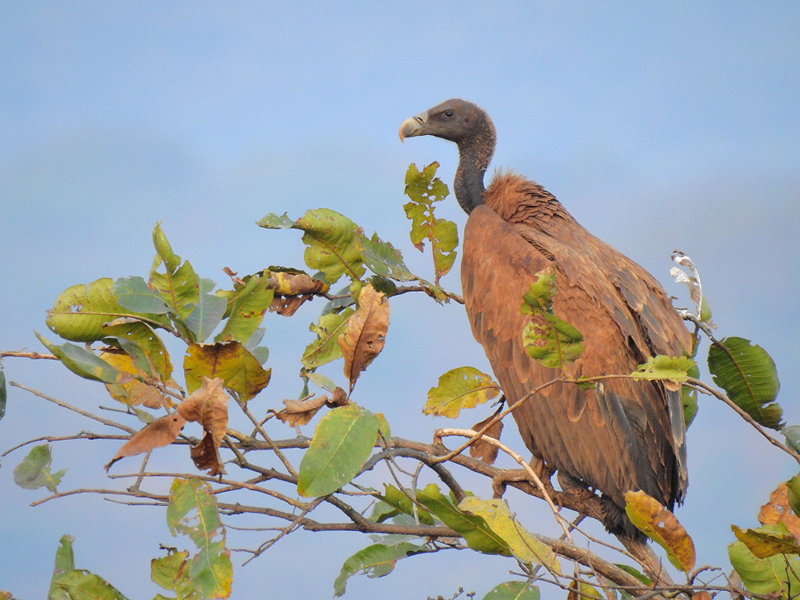
Indian Vulture Facts
- This impressive product of ages of evolution most frequently goes by the informative common name of the Indian Vulture. It has no other accepted general name in english. But, it’s named Vautour indien in French, and Indiengeier in German, among others.
- Within the scientific community, however, it’s better known by its technical title. Thankfully for the layperson, that’s a much simpler term to pronounce than many such. That’s because this natural marvel holds the short scientific moniker of Gyps indicus.
- The remarkable avian received that easy to pronounce name due to the efforts of the Italian naturalist, Giovanni Antonio Scopoli. The respected researcher accomplished the first recorded recognition of the intriguing animal in the year 1786.
- Unfortunately, the amazing bird has a population base that’s already seen a sharp decline in numbers. Estimates consider that loss to be at least 97% across the entirety of its known range. The IUCN thus accordingly lists it as Critically Endangered.
- The primary cause of that precipitous decline among the Indian Vulture seems to have been a drug given to cattle in its range. Upon feeding on the flesh of the injected cattle, that medicine, diclofenac, entered their systems. For the birds, it’s a powerful toxin.
- Given its precarious population situation, other factors now only serve to augment its perils. Most of these dangers stem from the actions of humans, either directly or indirectly. They include such threats to its existence as habitat loss and climate change.
Related Articles
Indian Vulture Physical Description
Like many of its relatives, the Indian Vulture often has a bad reputation in the minds of many. Yet, objectively speaking, it remains a fascinating creation of Nature and evolution. It captures the attention of many who encounter it, due its characteristic physical appearance.
In that regard, however, it follows a pattern strongly prevalent among birds. That’s true since it displays a certain degree of the physiological characteristic known as sexual dimorphism. In the case of this particular species, that trait manifests itself in terms of sheer size.
More specifically, females of the avian attain a greater average size than their male counterparts. The overall difference in this respect, though, remains relatively slight. To the untrained eye, therefore, distinguishing the genders based on this trait is extremely difficult.
As a general principle, however, specimens grow to an average body length of approximately 32 – 41 in (81 – 103 cm). An average wingspan, though, measures an impressive 6.4 – 7.8 ft (1.96 – 2.38 m). Exceptional individuals do occur, of course, regardless of gender.
The body of the Indian Vulture is considered medium-sized among its kindred. It does have a slightly bulkier form to it than many of those relatives. The neck and head appear nearly bald. Its broad wings develop as tapered, while the tail feathers remain relatively short.
Its upper layer of feathers, known as covert feathers, show a comparatively pale shade. The lower, primary feathers, on the other hand, display a much darker brownish-gray color. The bird also manifests a pale shaded collar-like pattern most highly visible behind the neck.
- Kingdom: Animalia
- Phylum: Chordata
- Class: Aves
- Order: Accipitriformes
- Family: Accipitridae
- Genus: Gyps
- Species: G. indicus
Indian Vulture Distribution, Habitat, and Ecology
The Indian Vulture evolved as native to a moderately small portion of the globe. For the moment, no evidence exists that it ever appeared anywhere outside of its present general zone of habitation. The precise reason for that lack of expansion remains undetermined.
As its name implies, the creature appears in the country of India, in the southern part of Asia. Even there, however, the intriguing avian only lives in the peninsular region. The species does exist, although in even smaller numbers, in the southeast section of Pakistan.
The animal also displays decidedly strong preferences regarding its habitat. In this, it also follows a pattern common to its many relatives. Most of the regions where it appears have a relatively hot, dry climate. It typically nests on rugged, remote cliffs or sometimes in trees.
Yet it doesn’t always shy away from human inhabited areas, either. That’s because, within its range, it sometimes makes its home in villages, towns, and even smaller cities. There, it occasionally builds its nest in man-made structures, including some temples in the region.
Once again maintaining the pattern of behavior common to its kind, the Indian Vulture feeds as a scavenger. Its food primarily consists of carrion, of virtually any species. This the highly evolved animal searches for by soaring high over the landscape, regardless of location.
Breeding season most often takes place between November and March. This generally occurs in larger colonies. Females typically lay a single egg, which both parents incubate. Hatching usually requires about 45 days. Individuals sometimes live for up to 40 – 45 years.
Species Sharing Its Range
Check out our other articles on 5 Marvelous Mediterranean Species, Ribbon Seal, Cumberland Falls, Red Maple, Lau Banded Iguana, Halloween Hermit Crab, Orange Wattle
